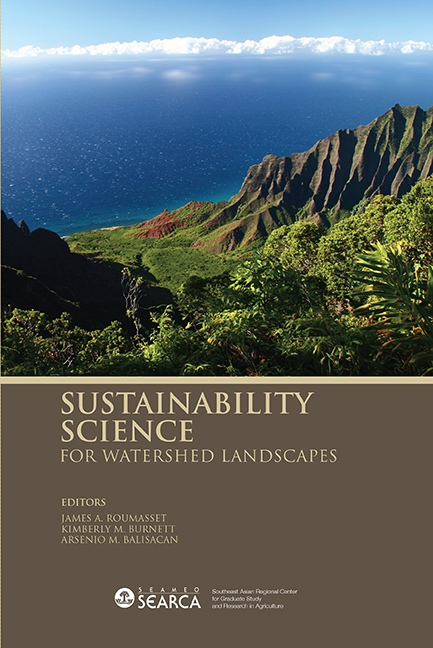Book contents
- Frontmatter
- Contents
- Tables
- Figures
- Message
- Foreword
- Preface
- Acknowledgments
- List of Contributors
- Theme 1 Sustainability Science for Resource Management and Policy
- Theme 2 Monitoring and Modelling
- Theme 3 Participatory Approaches
- 8 Landscape-Scale Conservation: Fostering Partnerships through Ecosystem Service Approaches
- 9 A Participatory Approach to Community Resource Management: Building Upon Local Knowledge and Concerns
- Theme 4 Case Studies
- Synthesis
8 - Landscape-Scale Conservation: Fostering Partnerships through Ecosystem Service Approaches
from Theme 3 - Participatory Approaches
Published online by Cambridge University Press: 21 October 2015
- Frontmatter
- Contents
- Tables
- Figures
- Message
- Foreword
- Preface
- Acknowledgments
- List of Contributors
- Theme 1 Sustainability Science for Resource Management and Policy
- Theme 2 Monitoring and Modelling
- Theme 3 Participatory Approaches
- 8 Landscape-Scale Conservation: Fostering Partnerships through Ecosystem Service Approaches
- 9 A Participatory Approach to Community Resource Management: Building Upon Local Knowledge and Concerns
- Theme 4 Case Studies
- Synthesis
Summary
ABSTRACT
The growing size and resource demands of the human population make it more important than ever to broaden options for integrating conservation into resource decisions and practices. Fostering collaboration through partnerships can engage resource users under a common framework. Focusing on ecosystem services can diversify the types of organisations and resource users who invest in, are supportive of, and participate in conservation efforts. Exploring partnerships emerging from these ecosystem service conservation projects can help inform future efforts for successful cooperation. Using two case studies – Sierra de las Minas in Guatemala and the Piracicaba, Capivari, and Jundiai (PCJ) watershed in Brazil – the formation, approaches, and strategies used are explored to contribute to the success of future partnerships. In both cases, the partnerships were initiated through third party leadership, governed by a committee including all stakeholders, and used direct payments for ecosystem services to encourage conservation efforts.
INTRODUCTION
Sustainability science refers to research that examines the mechanisms for and challenges of achieving sustainable development – reconciling human needs with environmental limits over the long term (Clark and Dickson 2003). The global pattern of expansion is such that sustainability science is critical in maintaining some level of human and environmental prosperity. As population grows, natural resources are consumed to maintain well-being. Resource use often entails land use and land conversion. Human population is expected to reach about 10 B within the next 50 years (United Nations 2007). This expansion comes with demands for natural resources (for food, shelter, fiber, fuel, etc.) (Foley et al. 2005). The use of such resources is coupled with conversion and/or intensive land use. Deforestation for agriculture is one example - one estimate holds that the global expansion of croplands since 1850 has converted some 6 M km2 of forests/woodlands (Ramankutty and Foley 1999).
Food production via agriculture is arguably the most important activity in the world today. Yet agriculture is the most important proximate cause of biodiversity loss and ecosystem service degradation worldwide, both directly via land conversion and indirectly through the use of fertilisers and agricultural technologies (Matson et al. 1997; Tilman et al. 2001; Foley et al. 2005).
- Type
- Chapter
- Information
- Sustainability Science for Watershed Landscapes , pp. 195 - 218Publisher: ISEAS–Yusof Ishak InstitutePrint publication year: 2010



